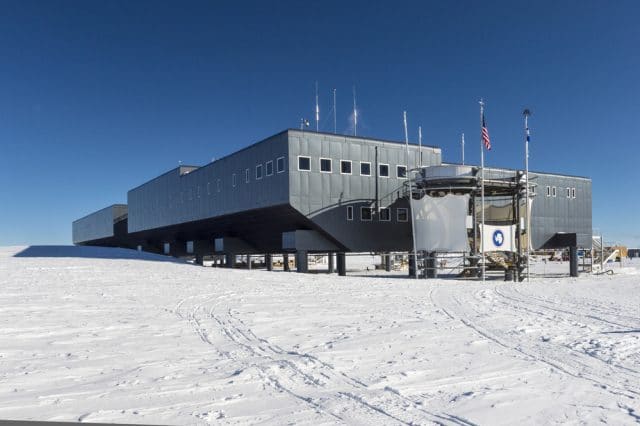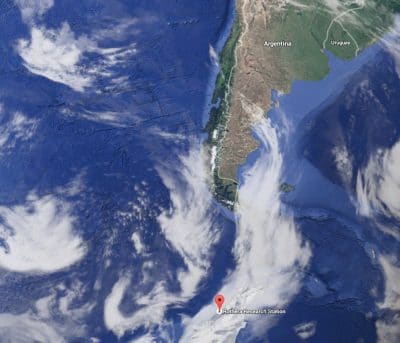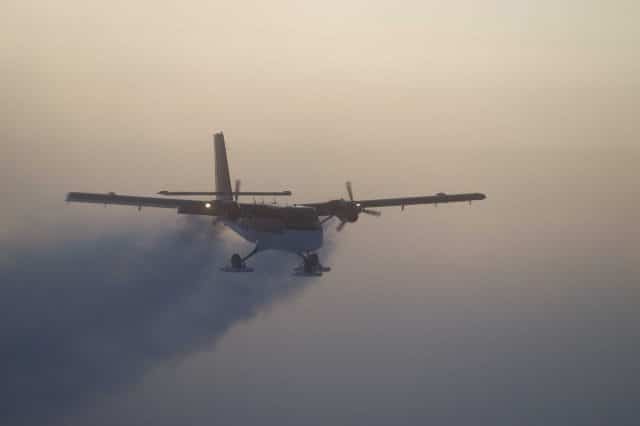Twin Otter Emergency Winter Flight to the South Pole
The Amundsen-Scott South Pole Station is not easy to reach. It’s located on Antartica’s ice sheet at an elevation of 2,835 metres (9,306 feet). Most of that elevation is the thickness of the ice sheet itself. The station drifts with the ice sheet about 10 metres (33 feet) every year.

The temperature ranges between -13.6°C (7.5°F) and -82.8°C (-117°F). In the summer, the station is staffed with about 150 people. In the winter, some 50 scientists and support personnel stay on while the station is cut off from the rest of the world.
In the dark winter months, the Amundsen-Scott South Pole Station is described as harder to get to than the International Space Station.
Only twice in the past 60 years has an attempt to reach the station been made in the winter but an evacuation attempt is in progress now for a Lockheed Martin employee who requires medical treatment.
The only aircraft that can make it through is the de Havilland Canada Twin Otter, a high wing, twin-engine turboprop. The de Havilland Canada Twin Otter Series 300 was introduced in 1969 and was wildly popular as a bush plane for remote areas. Production stopped in 1988.
(Not relevant to this flight but interesting: In 2005, the Canadian Forces budgeted for a light utility aircraft to replace the high-hour CC-138s they had been using. They discovered that no direct replacement for the aircraft existed and they were down to only four airworthy aircraft. Viking Air purchased the tooling and the type-certificates and in 2007 the Twin Otter Series 400 was then put into production, allowing the Twin Otter to maintain its position as the Canadian bush aircraft of choice.)
The Twin Otter is rugged and reliable and capable of flying in extremely low temperatures, landing on skis. The engine performance is reliable at -60°C. The light airframe and triangle gears keep the weight down, which is critical for fuel planning for the remote station. Further, the fuel as to be warmed for flight as the petrol freezes into jelly in the low temperatures. There’s no runway at the South Pole, so the Twotter needs to land in total darkness on compacted snow.

On Tuesday, the two Twin Otters operated by Canadian firm Kenn Borek Air departed Calgary for the first leg of the intercontinental flight to the Pole. According to Flight Aware, both of the aircraft, C-GKBO and C-GKBG, have arrived in Daniel Oduber Quirós International Airport (MRLB) in Costa Rica.
From Costa Rica, the planes need to cross South America and then fly to Rothera, a British research station on the Antarctic Peninsula. Rothera has a 900 metre (2,950 feet) crushed rock runway and a bulk storage fuel facility.
Once refueled at Rothera, one of the Twin Otters will continue to the South Pole to attempt to land and pick up the patient. The other Twin Otter will remain in Rothera as a search and rescue aircraft in case of emergency.
Flyby Rothera polar research Station from Discovering Antarctica on Vimeo.
A Twin Otter’s fuel endurance is usually 4-6 hours. Even with long-range tanks installed, the aircraft can only hold 12 or 13 hours of fuel on board. The flight to Amundsen-Scott South Pole Station is ten hours and there’s nowhere to divert to, other than to turn back.
The reported weather at the South Pole station as of 7:45 this morning (Friday the 17th) isn’t looking too warm.
| Temperature | -61°C | -77°F |
| Wind Chill | -83°C | -117°F |
| Wind Speed | 12 knots | |
| Air Pressure | 681 millibars | |
It was widely believed to be impossible to fly to Amundsen-Scott in the depths of winter. In 1999, an emergency room physician stationed on at the station for a year treated her own breast cancer until she could be evacuated. A flight was sent for her in October, which was the earliest that they’d ever tried to extract one of the winter crew.
The first time winter extraction was in 2001, when Dr Ronald Shemenski was diagnosed with inflammation of the pancreas and given only a 50% chance of survival if he remained on the station. Further, if he did not survive, the remaining 49 people on the station would be left without a doctor. Initially, the US Air Force planned to attempt the flight using C-130 Hercules but the temperatures were too low for the C-130 to make it through.
Canadian rescue pilots from Kenn Borek Air braved the night flight (daylight was limited to half an hour a day) through -70°C temperatures, high winds and snow in two eight-seater Twin Otters. The crew at Amundsen-Scott lit barrels of gasoline in the shape of a makeshift runway. After a successful landing and transfer, the pilots found to their dismay that the skis had stuck to the terrain and the grease on the wing flaps had frozen, leaving the flaps fully extended. They were able to hack the plane free of the “runway” and took off with what the pilot described as the longest and slowest take-off he had ever attempted.

In 2003, the same pilots with Kenn Borek Air made a second mission to Amundsen-Scott for a man with a serious infection in his gallbladder. Two Twin Otters departed Calgary following the same route, arriving in Rothera two days later. The weather was blowing snow conditions, which meant that the Twin Otter continuing on the South Pole had to delay the flight for a week. The flight departed Rothera at 00:48 Pole time (UTC+12) and arrived at 09:13. They departed again 12 hours later, the day before official sunrise, and brought the patient back to Rothera, where he was put on a flight to Punta Arenas in Chile for medical attention.
This will be the third ever winter flight to the South Pole. Details of the medical issue have not been released and it is unclear if one or two people are to be evacuated.
I’ll be watching C-GKBO on Flight Aware for updates, which I’ll post in the comments here and on the Fear of Landing Facebook page. The National Science Foundation estimated that the earliest that the aircraft could reach the station is on Sunday the 19th but as they appear to still be parked in Costa Rica, I can’t see how they could make it before next week.








This type of operation is “VFR”: Very F..ing Risky !
I do not think that I would be able to operate an aircraft under those conditions. Only those who have a lifetime of experience in a very cold climate, like Alaska, Canada, Siberia, Skandinavia can have a hope to acquire the necessary skills and even then, only the very best of pilots trained and experienced to operate under those extremely extreme conditions have a hope of making it.
The “Twotter” is a twin turboprop, jet fuel is used. I presume that it will contain additives to enable a continuous fuel flow to the engines. In light jets we used an additive called “Prist”. And I guess that fuel heaters may barely be adequate. Jet fuel (kerosine) can indeed become “lumpy”. Fuel heaters usually feed the fuel through heat exchangers from the engines. I suppose they will need “Prist” as well (pre-mixed, not in the aerosol cans it often is sold in).
At very high altitudes, in the stratosphere, the temperature drops to about -60 centigrade. You mention temperatures down to minus 82.8, Sylvia. That is colder than the air temperature in the upper atmosphere. Brave pilots who attempt to fly under those conditions!
I’m totally stealing this line.
Sylvia, Thank You again and again. This story is riveting and your writing style is ‘The Best’.
It’s easy: the pilots and the planes make all the exciting stories, I just have to write them down. :)
Curt,
Hear hear, I could not agree more. This is a superb site, very well researched, very well written, very professional and very informative!
And I want to add my “go raibh mile maith agat” to Sylvia!
(What that means? Look it up ! Clue: I live in Ireland.)
Awww!
Sylvia,
You now sounded like the famous sculptor.
When he was asked how he managed to create those beautiful works of art he replied: “It is easy, they already were in the block of marble. All I had to do is chip away the surplus material!”
wow.
Those are scary flights..
For those interested, there is a blog/site from Amundsen-Scott. No further news however at the moment.
http://www.southpolestation.com/
Great post on PPRuNe by a Twin Otter pilot who has landed at the South Pole five times:
Quote:
> I’d bet a beer that a DHC7 could do it and with some 2.5 times the payload of a DHC6
I think not………
South Pole is 9,300ft above sea level, and does not have a runway – the only aircraft that operate into there are Twin Otters on skis, and Air National Guard LC-130 (ski-fitted Hercules). The LC130s operate off over 10,000ft of groomed snow (that is maintained through the short summer operating season). The Twin Otter obviously needs much less skiway.
As far as I know, the LC-130 has a minimum temperature for take-off and landing of -50C (hydraulic system limitation?). Twin Otter, with simpler systems, has been operated down to -60C. (Would have to dig out my books to check the official limit).
Year round average surface temperature at South Pole is -49C, and can get into the minus 80s. At this time of year, the average temperature is between -55 and -62C. The operating window for routine operation of the LC 130s to Pole is early November to late February. (Today looks like a warmish day there for the time of year, -51C, 1600m in blowing snow)
The flight from Rothera (British base at 67S on the Antarctic Peninsula) to Pole is about 1300nm, approximately 10 hours in a ski-fitted Twotter. Ferry tanks in the back, PNR approximately half way, nowhere else possible to land. Almost the whole route in complete darkness, including the landing on a skiway with no proper lighting. Although there have now been 3 landings at Pole during the winter, two were early or late when there was still a bit of light in the sky. I believe only one was in total darkness – this one is going to be pretty close to mid-winter.
(2500 hrs ski Twin Otter inc 5 landings at South Pole, 2000 hrs DHC7)
Full thread here: http://www.pprune.org/rumours-news/580491-where-twotter-goes-even.html
An NSF spokesperson has stated that, as of Sunday afternoon, the two planes were on the ground in Punta Arenas, Chile, waiting for better weather to cross to Rothera.
NSF release from yesterday: They’ve reached Rothera.
http://www.nsf.gov/news/news_summ.jsp?cntn_id=138982&
about 5 days later mainstream media picks up on this article
https://www.theguardian.com/world/2016/jun/21/antarctica-polar-rescue-planes-medical-emergency
it’s not a full copy, but they even took the same images…
There’s definitely a feeling of “inspired by” there, I think! Thanks for pointing me at the piece.
Mind you, if they’d done the research, they would have known that the aircraft touched down at the South Pole yesterday when they posted the article :)
There has been very little coverage of this monumental rescue on the TV news in New Zealand. A few details were broadcasted on out mid-day news today, Thursday 23rd June. I agree, anyone who is posting this as their job needs to be aware of all updates. I understand that now one plane is returning to Chile .
Latest update from CBC, June 22nd, 7.07 p.m. MT. ——————————————
A Calgary-based team has arrived in Chile after rescuing two people in need of medical attention from an Antarctic research facility at the South Pole.
—————————————————–
We can be so thankful for this recovery, and proud of brave men .pilots, co-pilots, engineers and medical crew, ground crew and all support people throughout who have monitored weather, manned tracking stations, and so much more.
Facebook
Twitter
Reddit
Google
Share
Email
Related Stories
■ Calgary-based airline’s rescue mission to Antarctica arrives in Rothera
■ Calgary airline sends planes to Antarctic on potentially dangerous rescue mission
■ Crews capable of risky South Pole rescue mission, says former Kenn Borek Air pilot
External Links
■NSF Facebook Page
(Note: CBC does not endorse and is not responsible for the content of external links.)
A Calgary-based team has arrived in Chile after rescuing two people in need of medical attention from an Antarctic research facility at the South Pole.
Yes, they did it! Wonderful!
The NSF have published a thank you to all of us for
being obsessedfollowing along:https://www.facebook.com/Division-of-Polar-Programs-National-Science-Foundation-1392901317615113/
Public statement of thanks from Kelly K. Falkner, head of the U.S. Antarctic Program
On behalf of all of us in the U.S. Antarctic Program, I wish to thank the people around the globe who used our Facebook page to express their support for the Kenn Borek pilots, the South Pole community, the British Antarctic Survey and all of our national and international colleagues who contributed to this week’s medical-evacuation flight.
Social media bring the world together in so many ways, few more admirable than this.
http://www.cbc.ca/news/canada/calgary/kenn-borek-air-weather-delays-june-20-1.3645013
The small Twin Otter plane operated by Calgary’s Kenn Borek Air made the 2,400 kilometre, nine-hour trip on Tuesday through the dark and cold from a British base on the Antarctic peninsula.
NSF confirmation: https://twitter.com/NSF_OPP/status/745375475594297344
What are the names of the crew? I did not see them mentioned, only the name of the company. Or is it a practice not to do so?
That’s a good question and I don’t know the answer (we tend not to name the crew in accident reports but hey, this was a success!). I’ll see what I can find out.